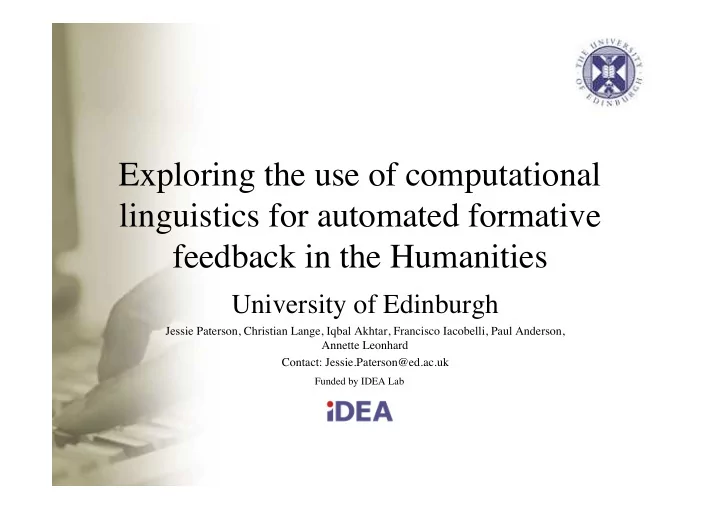

Exploring the use of computational linguistics for automated formative feedback in the Humanities University of Edinburgh Jessie Paterson, Christian Lange, Iqbal Akhtar, Francisco Iacobelli, Paul Anderson, Annette Leonhard Contact: Jessie.Paterson@ed.ac.uk Funded by IDEA Lab
Presentation Format • Background • Quality criteria – Observed – Automated • Potential computational techniques – Content feedback – Surface features • Examples • Conclusions and the future
Introduction • Feedback to students is recognised as a highly important part of the student experience BUT it is difficult to provide it timely. • Students want feedback as they work on written work and this is often too time consuming for teaching staff to provide. • Although all written work is marked to strict marking schemes, a substantial amount of subjectivity in terms of the marker is also involved.
Project layout • This explorative project set out to explore how computational techniques might be used to provide students with “tentative” feedback on written work - students could then use this to re- work before final submission. • This investigation used one course - both essays & collaborative wikis. • The study was split into 2 components:- – Defining the quality criteria used by the markers – Surveying possible computational methods
Note • The presentation only gives a few illustrative examples for each of the sections - please see full paper for further examples and details • This work is NOT about assessment; it is about giving tentative automated feedback that students can use as they wish.
Quality criteria • The quality criteria were defined by two methods:- – examining the written work and comparing the awarded marks with the comments provided by the marker to extract the features that differentiated the work. Further refining through discussions with the marker produced a list of criteria – automated analysis of the student work to see if this could highlight further features using: Linguistic Inquiry and Word Count (LIWC), and WordSmith Tools
Observed Criteria Some examples from final list • Referencing – The use of primary sources in referencing is highly encouraged • Style/Terminology – Use the active voice and abstain from the passive voice as much as possible. Run-on sentences should be separated into two sentences. • Structure – When appropriate, employ discursive writing techniques
Automated Analysis Some examples from the final results • Linguistic Inquiry and Word Count (LIWC) – For essays: Punctuation - More use of the period, colon, question mark, dash, quotation marks (inverted commas), parentheses, and punctuation marks overall; less use of semi-colon and apostrophe • Wordsmith tools showed that higher marked essays: – Have more distinct terms (non-repetitive); more higher lettered words; longer vocabulary terms, etc
Potential Computational techniques Split into two areas:- • Content Feedback - potential issues related to content and its presentation in essays • Surface features of style - surface features of writing that may result in confusing or poorly formatted text
Content Feedback • Clear Question and Thesis - analysis of the first paragraph can be a good proxy to determine whether the introduction is motivating, and poses a question and a thesis – Methods include TextTiling perhaps enhanced with LSA • Sufficient Context - for example, whether there is a balance among theological, social, historical and anthropological contexts. This is somewhat subjective to assess. – Methods include use dictionaries
Content Feedback cont.. • Breadth of Background Research - Broad generalisations may be an indicator of narrow reading. Lists of entities and parts of speech (POS) around them can help determine breadth. – Methods include POS analysis • Authoritative Sources for a Topic - Web searches can be used to check the sources used. – Methods include citation count or “link:” operator, etc
Content Feedback cont.. • Multiple Layers of meaning - For essays with complex events, background and implications, authors are prone to lose focus. – Methods include counting the number of references by paragraph or number of conjunctions such as "in addition," "moreover," etc. and the number of subordinating conjunctions such as “because” and “in order to/that.”
Content Feedback cont.. • Weakly Presented Arguments - To make a claim and support it, the wording should avoid ambiguities and weak or overly cautious interpretations. – Methods include counting words such as “perhaps”, “maybe”, “possibly”, “potentially”, etc. and compare them with a preset threshold of frequency of such words
Content Feedback cont.. • Lack of Consistency Between Definitions and Use of a Word – hard to do. – Use of concordances may assist • Cognitive Choices Based on Word categories - Using dictionaries that allow categorisation of the text in multiple dimensions may be useful – LIWC
Surface features of style • Many can be implemented simply using POS “tagger” followed by some simple post-processing - for example, LT-TTT2 provides natural language processing (NLP) • Include things like:- – References in the correct format – Enough or too few references – Heavy use of nominals
Examples • To illustrate some of the methods small extracts of a few pieces of work were tested using TextTiling and LIWC • Both cases the results followed the trends given by the markers
Conclusions and the Future • We have developed some quality criteria and guidelines for producing good writing in one course. • We identified a number of objective features which correlate with the “good” and “bad” writing. • A survey of a range of computational linguistic techniques showed the potential to build a framework built on simple techniques that could provide valuable feedback to students on these features. • The framework would be built to integrate independent modules created and evolved by different developers - while presenting a consistent and integrated interface to the student. • We are seeking funding to take this forward.
Recommend
More recommend